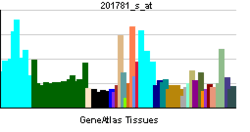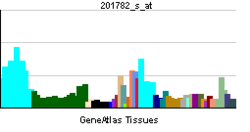AH receptor-interacting protein
AH receptor-interacting protein (AIP) also known as aryl-hydrocarbon receptor-interacting protein, immunophilin homolog ARA9, or HBV X-associated protein 2 (XAP-2) is a protein that in humans is encoded by the AIP gene.[1][2][3]
Function
AIP may play a positive role in aryl hydrocarbon receptor-mediated signalling possibly by influencing its receptivity for ligand and/or its nuclear targeting. AIP is the cellular negative regulator of the hepatitis B virus (HBV) X protein.[1]
Role in Disease
AIP mutations may be the cause of a familial form of acromegaly, familial isolated pituitary adenoma (FIPA). Somatotropinomas (i.e. GH-producing pituitary adenomas), sometimes associated with prolactinomas, are present in most AIP mutated patients.[4]
Interactions
AIP has been shown to interact with the aryl hydrocarbon receptor,[3][5][6] peroxisome proliferator-activated receptor alpha[7] and the aryl hydrocarbon receptor nuclear translocator.[3][8]
References
- ↑ 1.0 1.1 "Entrez Gene: AIP aryl hydrocarbon receptor interacting protein".
- ↑ Kuzhandaivelu N, Cong YS, Inouye C, Yang WM, Seto E (December 1996). "XAP2, a novel hepatitis B virus X-associated protein that inhibits X transactivation". Nucleic Acids Res. 24 (23): 4741–50. doi:10.1093/nar/24.23.4741. PMC 146319. PMID 8972861.
- ↑ 3.0 3.1 3.2 Carver LA, Bradfield CA (April 1997). "Ligand-dependent interaction of the aryl hydrocarbon receptor with a novel immunophilin homolog in vivo". J. Biol. Chem. 272 (17): 11452–6. doi:10.1074/jbc.272.17.11452. PMID 9111057.
- ↑ Occhi G, Trivellin G, Ceccato F et al. (2010). "Prevalence of AIP mutations in a large series of sporadic Italian acromegalic patients and evaluation of CDKN1B status in acromegalic patients with multiple endocrine neoplasia.". Eur. J. Endocrinol. 163 (3): 369–376. doi:10.1530/EJE-10-0327. PMID 20530095.
- ↑ Petrulis JR, Hord NG, Perdew GH (December 2000). "Subcellular localization of the aryl hydrocarbon receptor is modulated by the immunophilin homolog hepatitis B virus X-associated protein 2". J. Biol. Chem. 275 (48): 37448–53. doi:10.1074/jbc.M006873200. PMID 10986286.
- ↑ Ma Q, Whitlock JP (April 1997). "A novel cytoplasmic protein that interacts with the Ah receptor, contains tetratricopeptide repeat motifs, and augments the transcriptional response to 2,3,7,8-tetrachlorodibenzo-p-dioxin". J. Biol. Chem. 272 (14): 8878–84. doi:10.1074/jbc.272.14.8878. PMID 9083006.
- ↑ Sumanasekera WK, Tien ES, Turpey R, Vanden Heuvel JP, Perdew GH (February 2003). "Evidence that peroxisome proliferator-activated receptor alpha is complexed with the 90-kDa heat shock protein and the hepatitis virus B X-associated protein 2". J. Biol. Chem. 278 (7): 4467–73. doi:10.1074/jbc.M211261200. PMID 12482853.
- ↑ Kazlauskas A, Sundström S, Poellinger L, Pongratz I (April 2001). "The hsp90 chaperone complex regulates intracellular localization of the dioxin receptor". Mol. Cell. Biol. 21 (7): 2594–607. doi:10.1128/MCB.21.7.2594-2607.2001. PMC 86890. PMID 11259606.
Further reading
- Chen HS, Perdew GH (1994). "Subunit composition of the heteromeric cytosolic aryl hydrocarbon receptor complex.". J. Biol. Chem. 269 (44): 27554–8. PMID 7961671.
- Ma Q, Whitlock JP (1997). "A novel cytoplasmic protein that interacts with the Ah receptor, contains tetratricopeptide repeat motifs, and augments the transcriptional response to 2,3,7,8-tetrachlorodibenzo-p-dioxin.". J. Biol. Chem. 272 (14): 8878–84. doi:10.1074/jbc.272.14.8878. PMID 9083006.
- Meyer BK, Pray-Grant MG, Vanden Heuvel JP, Perdew GH (1998). "Hepatitis B virus X-associated protein 2 is a subunit of the unliganded aryl hydrocarbon receptor core complex and exhibits transcriptional enhancer activity.". Mol. Cell. Biol. 18 (2): 978–88. PMC 108810. PMID 9447995.
- Carver LA, LaPres JJ, Jain S et al. (1999). "Characterization of the Ah receptor-associated protein, ARA9.". J. Biol. Chem. 273 (50): 33580–7. doi:10.1074/jbc.273.50.33580. PMID 9837941.
- Gadelha MR, Une KN, Rohde K et al. (2000). "Isolated familial somatotropinomas: establishment of linkage to chromosome 11q13.1-11q13.3 and evidence for a potential second locus at chromosome 2p16-12.". J. Clin. Endocrinol. Metab. 85 (2): 707–14. doi:10.1210/jc.85.2.707. PMID 10690880.
- Petrulis JR, Hord NG, Perdew GH (2001). "Subcellular localization of the aryl hydrocarbon receptor is modulated by the immunophilin homolog hepatitis B virus X-associated protein 2.". J. Biol. Chem. 275 (48): 37448–53. doi:10.1074/jbc.M006873200. PMID 10986286.
- Kazlauskas A, Poellinger L, Pongratz I (2001). "The immunophilin-like protein XAP2 regulates ubiquitination and subcellular localization of the dioxin receptor.". J. Biol. Chem. 275 (52): 41317–24. doi:10.1074/jbc.M007765200. PMID 11013261.
- Kazlauskas A, Sundström S, Poellinger L, Pongratz I (2001). "The hsp90 chaperone complex regulates intracellular localization of the dioxin receptor.". Mol. Cell. Biol. 21 (7): 2594–607. doi:10.1128/MCB.21.7.2594-2607.2001. PMC 86890. PMID 11259606.
- Kazlauskas A, Poellinger L, Pongratz I (2002). "Two distinct regions of the immunophilin-like protein XAP2 regulate dioxin receptor function and interaction with hsp90.". J. Biol. Chem. 277 (14): 11795–801. doi:10.1074/jbc.M200053200. PMID 11805120.
- Patterson CE, Gao J, Rooney AP, Davis EC (2002). "Genomic organization of mouse and human 65 kDa FK506-binding protein genes and evolution of the FKBP multigene family.". Genomics 79 (6): 881–9. doi:10.1006/geno.2002.6777. PMID 12036304.
- Berg P, Pongratz I (2002). "Two parallel pathways mediate cytoplasmic localization of the dioxin (aryl hydrocarbon) receptor.". J. Biol. Chem. 277 (35): 32310–9. doi:10.1074/jbc.M203351200. PMID 12065584.
- Dull AB, Carlson DB, Petrulis JR, Perdew GH (2002). "Characterization of the phosphorylation status of the hepatitis B virus X-associated protein 2.". Arch. Biochem. Biophys. 406 (2): 209–21. doi:10.1016/S0003-9861(02)00444-7. PMID 12361709.
- Strausberg RL, Feingold EA, Grouse LH et al. (2003). "Generation and initial analysis of more than 15,000 full-length human and mouse cDNA sequences.". Proc. Natl. Acad. Sci. U.S.A. 99 (26): 16899–903. doi:10.1073/pnas.242603899. PMC 139241. PMID 12477932.
- Sumanasekera WK, Tien ES, Turpey R et al. (2003). "Evidence that peroxisome proliferator-activated receptor alpha is complexed with the 90-kDa heat shock protein and the hepatitis virus B X-associated protein 2.". J. Biol. Chem. 278 (7): 4467–73. doi:10.1074/jbc.M211261200. PMID 12482853.
- Zhao Y, Meng XM, Wei YJ et al. (2004). "Cloning and characterization of a novel cardiac-specific kinase that interacts specifically with cardiac troponin I.". J. Mol. Med. 81 (5): 297–304. doi:10.1007/s00109-003-0427-x. PMID 12721663.
- Lees MJ, Peet DJ, Whitelaw ML (2003). "Defining the role for XAP2 in stabilization of the dioxin receptor.". J. Biol. Chem. 278 (38): 35878–88. doi:10.1074/jbc.M302430200. PMID 12837759.
- Yano M, Terada K, Mori M (2003). "AIP is a mitochondrial import mediator that binds to both import receptor Tom20 and preproteins.". J. Cell Biol. 163 (1): 45–56. doi:10.1083/jcb.200305051. PMC 2173431. PMID 14557246.
- Ramadoss P, Petrulis JR, Hollingshead BD et al. (2004). "Divergent roles of hepatitis B virus X-associated protein 2 (XAP2) in human versus mouse Ah receptor complexes.". Biochemistry 43 (3): 700–9. doi:10.1021/bi035827v. PMID 14730974.
- Occhi G, Trivellin G, Ceccato F et al. (2010). "Prevalence of AIP mutations in a large series of sporadic Italian acromegalic patients and evaluation of CDKN1B status in acromegalic patients with multiple endocrine neoplasia.". Eur. J. Endocrinol. 163 (3): 369–376. doi:10.1530/EJE-10-0327. PMID 20530095.

